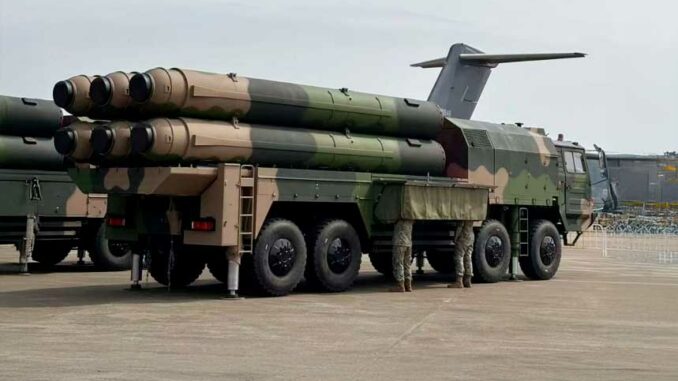
China presents the HQ-29, a twin-barrel exoatmospheric interceptor capable of neutralizing ballistic missiles and satellites from 500 km away.
The HQ-29 is a new-generation Chinese interceptor, seen for the first time during rehearsals for a parade in Beijing. Mounted on a six-axle launcher truck and equipped with two missile containers approximately 1.5 meters wide, it combines high-altitude ballistic missile defense and low-orbit satellite defense capabilities. It fills the gap between the HQ-19 (high-altitude interceptor) and the HQ-9 series (terminal defense) and is comparable to the American SM-3 and Russian S-500 systems. Its range is said to exceed 500 km, marking a major strategic advance in Chinese space defense.
Unveiling of the HQ-29 system in China
The HQ-29 was first spotted during rehearsals for a military parade in Beijing. Images posted on social media showed a six-axle launch vehicle carrying two missile containers with an estimated diameter of 1.5 meters, or approximately 4.9 feet. This configuration had already sparked speculation a few weeks earlier. Its public presentation confirms its existence and reveals a new stage in air defense capabilities.
The choice of a public parade suggests Beijing’s desire to formalize this system as a strategic part of its military posture. The imposing size of the containers suggests advanced technology. The system appears to exceed the capabilities of existing aircraft, both at high altitudes and in space.
Technical characteristics of the HQ-29
Based on initial observations, the HQ-29 is distinguished by several technical features:
- Missile containers: two large tubes 1.5 meters in diameter, suggesting powerful mechanics suited to high-performance interceptors, much larger than those of the HQ-19 or HQ-9.
- Dual configuration: two missiles ready for launch, increasing the probability of intercepting fast or multiple targets.
- Estimated range: greater than 500 km, which places the HQ-29 in the category of exo-atmospheric interceptors, similar to the American SM-3 or the Russian S-500.
These elements combined demonstrate a clear technical ambition: enabling medium- or long-range interceptions in or above the stratosphere represents a leap forward in China’s space defense strategy.

Strategic positioning in Chinese missile defense
The HQ-29 completes China’s multilayer defense system.
- The HQ-9, designed for low-altitude terminal defense.
- The HQ-19, a high-altitude interceptor comparable to the US THAAD system.
- The HQ-29 fills the gap between the two as an intermediate or exo-atmospheric interceptor also capable of threatening low-orbit satellites.
This strategic hierarchy illustrates a desire to build comprehensive coverage of ballistic and space trajectories. The HQ-29 gives China an early, strategic interception capability, limiting its adversaries’ options in space.
International comparative implications
Similar systems include:
- The US SM-3: a naval interceptor capable of engaging ballistic missiles in mid-flight.
- The Russian S-500: designed for exo-atmospheric engagements and advanced air defense.
- The Russian PL-19 Nudol: an anti-satellite interceptor also capable of exo-atmospheric action.
The HQ-29 stands out by positioning itself at this technical level, demonstrating China’s strategic rise in the military space. Its presentation signals a desire to rival the capabilities of historical superpowers.
Consequences and prospects
The entry into service of the HQ-29 heralds several major consequences:
- For China, it is a materialization of exo-atmospheric capabilities, strengthening its deterrence and potentially changing the strategic calculations of its adversaries.
- For other powers, it requires an adaptation of their own space defenses. The United States and Russia could be pushed to accelerate their programs such as SM-3 or S-500.
- In the military sphere, the line between missile defense and space control is becoming blurred. The HQ-29 symbolizes this hybridization.
- Diplomatically, this heralds a phase of tension around the militarization of space, with questions about the future space security regime.
This system is not just a prototype; it marks a new stage in space defense strategy. It embodies a desire for strategic control over ballistic and orbital trajectories. If confirmed, the HQ-29 will redraw the military balance in space and reactivate a technological race with far-reaching consequences.
War Wings Daily is an independant magazine.